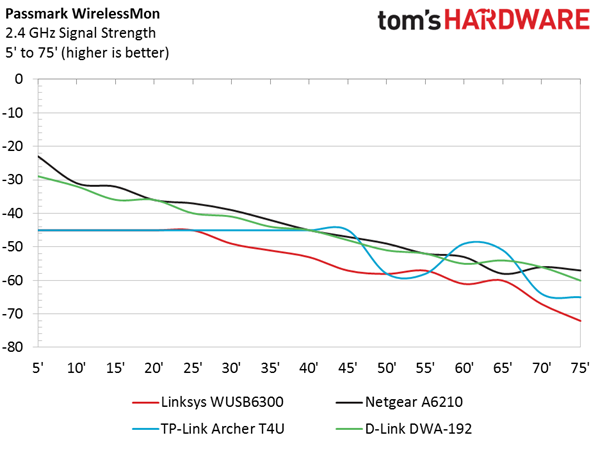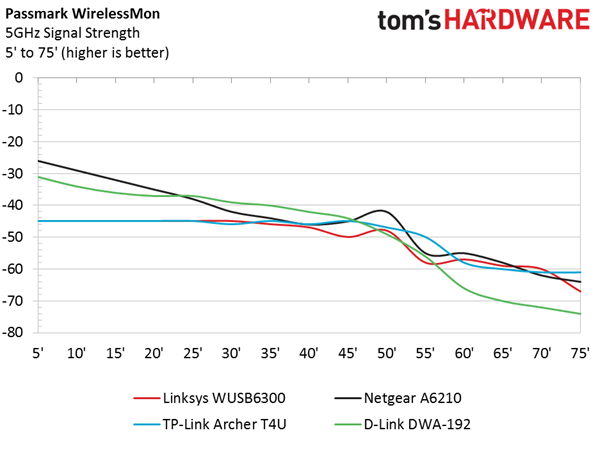D-Link DWA-192 USB Wi-Fi Adapter Review
Today, we take a closer look at D-Link's orb-shaped DWA-192 USB Wi-Fi adapter, one of the first AC1900 USB devices in today's market.
Why you can trust Tom's Hardware
Test Results And Conclusion
We put D-Link's DWA-192 through our entire Wi-Fi adapter testing suite. This is done in a standardized and reproducible fashion to generate reliable and consistent results. See How We Test USB Wi-Fi Adapters for more details on our test methodology and setup.
Signal Strength: Passmark WirelessMon
Signal strength does not consistently predict throughput. However, a solid signal is necessary for consistent performance.
We tested the DWA-192 on both bands with Passmark WirelessMon to isolate the signal strength and graph it against the competition. While D-Link's adapter is rated for AC1900 data rates (and one of the first models with that designation), everything else in our lab is AC1200-capable. These adapters include Linksys' WUSB6300, TP-Link Archer's T4U and the leader in our round-up, the Netgear A6210.
First up is the signal strength on the 2.4GHz band. D-Link's DWA-192 achieves excellent performance at all ranges from 5 to 75 feet (1.5 to 23 meters). In fact, it matches our previous champion in this test, Netgear's A6210. The other adapters—TRENDnet's TEW-805UB and Linksys' WUSB6300—clearly trail in signal strength at each distance.
Next, we look at the same group's signal strength utilizing the 5GHz band, again, using Passmark WirelessMon. The DWA-192 boasts strong performance at up to about 55 feet, but then drops off to trail its competition. This is made worse by the fact that the other adapters only employ a single set of antennas.
Overall, D-Link's signal strength is strong. It keeps pace with the leaders in both bands, except for when it's forced to transfer over longer distances on a 5GHz network.
Throughput: IxChariot
IxChariot is used for throughput testing. We report data on both the 2.4GHz and 5GHz bands at three distances: five feet (1.5m), 25 feet (7.6m) and 50 feet (15 m).
Get Tom's Hardware's best news and in-depth reviews, straight to your inbox.

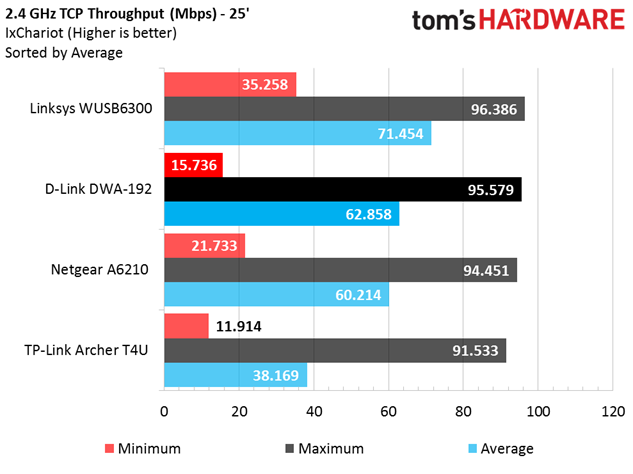
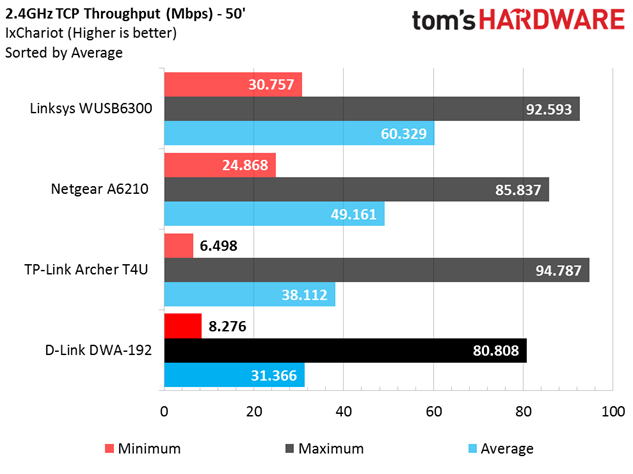
While higher performance is usually available on the 5GHz band, there are still times when 2.4GHz performance matters. In this discipline, D-Link's DWA-192 is hardly impressive. At the close five-foot distance, its average speed of 69.8 Mb/s puts it in third place behind Linksys' WUSB6300 and Netgear's A6210. Really, if you're in the same room as your router, just hook up your client via Ethernet if possible.
Moving out to 25 feet yields a mean throughput of 62.8 Mb/s, resulting in a second-place finish behind the WUSB6300. While D-Link's DWA-192 hit a maximum throughput of 95.6 Mb/s, right up there with Linksys, its low minimum performance holds back the average.
Finally, 50 feet out, the DWA-192 falls into last place with a mean throughput of 31.3 Mb/s, half as fast as Linksys' 60.3 Mb/s.
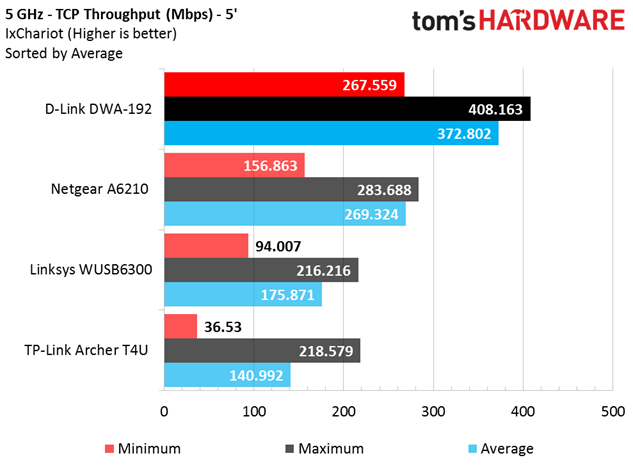
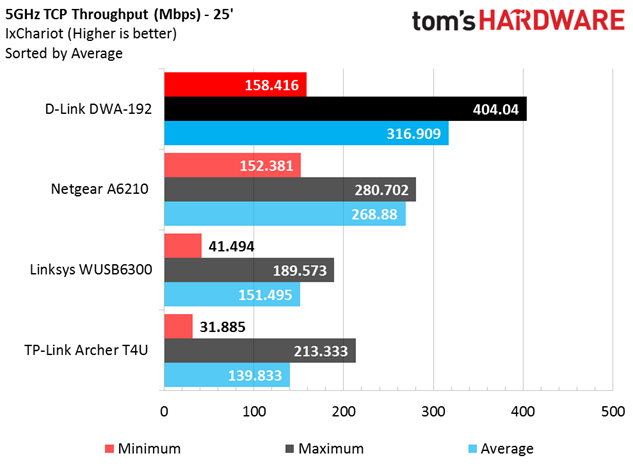
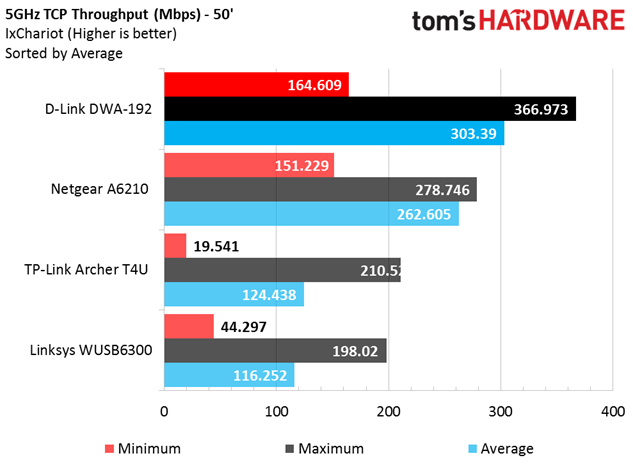
Next, we look at the throughput of D-Link's DWA-192 on the 5GHz band. If you have access to a 5GHz network, take advantage of its higher maximum performance and lower interference.
The DWA-192 demonstrates solid performance at every distance we tested. From five feet away, average throughput is a blistering 372.8 Mb/s. At 25 feet, it drops a bit, but still hits a class-leading 316.9 Mb/s, and as we moved out to 50 feet, the throughput remains a healthy 303.3 Mb/s. In all three cases, D-Link's DWA-192 is the fastest adapter we've tested.
Conclusion
When we tested D-Link's previous flagship, the DWA-182, we were not impressed. In fact, we called its slower speeds out. It seems the company doubled its efforts though, and its latest creation, the DWA-192, is far more impressive. Three sets of antennas might sound like overkill, but the proof is in our 5GHz performance numbers, which trounce the competition.
Our enthusiasm is tempered by some caveats. First, the DWA-192 is clearly designed for desktop PCs; enthusiasts looking for more mobile-friendly connectivity should look elsewhere. The base's extra weight does result in quite a bit of heft. Next, you need to be ok with a driver-only software package. The DWA-182 had a large software installation that this model does not include, leaving out some advanced controls. Finally, the DWA-192's 2.4GHz performance, while not terrible, is hardly worth paying extra for.
D-Link's DWA-192 stands out for now, seeing as it's the only AC1900 model available at this time. Desktop enthusiasts looking for high performance over Wi-Fi should consider it, so long as they intend to use the 5GHz band.
MORE: USB Wi-Fi Adapter 101
MORE: How We Test USB Wi-Fi AdaptersMORE: All Networking ContentMORE: Networking in the Forums
Jonas DeMuro is an Associate Contributing Writer for Tom's Hardware.
Follow us on Facebook, Google+, RSS, Twitter and YouTube.

Jonas P. DeMuro is a freelance reviewer covering wireless networking hardware.
-
CaedenV Ugly as sin, but it looks like they actually managed to get an OK product out the door. I might consider something like this for clients who have desktops that just cant have a wired connection run to them.Reply -
Alex Atkin UK This review makes no sense. How can you call it out for a weak long-range signal when the test shows it beats everything at long-range performance? Signal strength is moot if the performance is still there.Reply
Its far from 1300 performance though, I get the same max speed from an internal Intel 2x2 card connected at 833, although it tails off a lot quicker over distance than this as clearly the extra antenna improve long-range reception quality. -
digitaldoc Indeed, "Signal strength does not consistently predict throughput," and this is another example of this.Reply -
photonboy digitaldoc,Reply
Read the article again:
"Signal strength does not consistently predict throughput. However, a solid signal is necessary for consistent performance." -
nukemaster Reply
The drop is signal strength occurs past 55 feet.17642931 said:This review makes no sense. How can you call it out for a weak long-range signal when the test shows it beats everything at long-range performance? Signal strength is moot if the performance is still there.
Its far from 1300 performance though, I get the same max speed from an internal Intel 2x2 card connected at 833, although it tails off a lot quicker over distance than this as clearly the extra antenna improve long-range reception quality.
The test only goes to 50 feet.
They should test the speed at 75 feet just to see how much the reduction in signal effects it. -
Alex Atkin UK Reply17647212 said:The drop is signal strength occurs past 55 feet.
The test only goes to 50 feet.
They should test the speed at 75 feet just to see how much the reduction in signal effects it.
Exactly my point. I have been using WiFi since 802.11b so am all too aware of how unpredictable it can be and how signal strength is practically meaningless. Quite often you get a good signal strength and poor performance (as its not necessarily a good signal quality) and moving the client will result in a weaker signal strength with better performance, because you pick up a cleaner signal.
Before crosstalk became an issue I used to be able to get a usable (just barely) link at -79dBm on 2.4Ghz, but now with the number of WiFi networks around its no real indication of performance at all. Its also normal to have a much weaker signal on 5Ghz without necessarily impacting performance at all. -
jfolander USD129 seems a hefty list price. Here in China, the DWA-129 is currently listed at 343 Chinese Yuan which is about USD53 (including Chinese VAT). This price is on jd.com which has a good reputation.Reply
